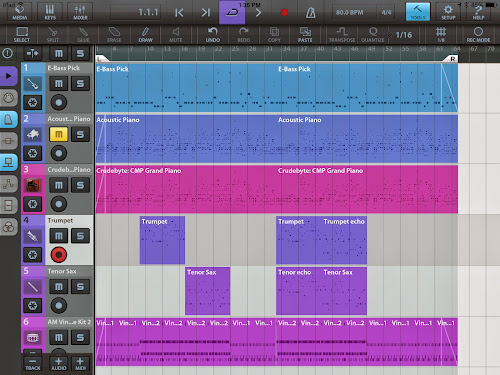Its been quite awhile since I posted anything here so I thought I'd maybe take some time to catch up with how the iPad has evolved and how music making on it compares to the desktop.
As I've posted before, I use Logic Pro X on my desktop as my preferred DAW and when on the iPad what I tend to miss most is the ease of working within a single app or DAW without feeling like I'm juggling multiple apps with multiple interfaces. In the past few years, DAWs on the iPad have matured quite a bit and here is my own experiences with them.
In the 'good old days' of the iPad, compromises had to be made for memory and CPU which basically made most DAWs self-contained entities with limited music making capabilities. One of the first I used was the (still excellent)
NanoStudio which had a very good internal synth coupled with a nice sample pad. What NanoStudio showed was that a traditional track-based DAW could work very well with a touch interface. Similar products out early include
BeatMaker 2,
Tabletop and
MultiTrack DAW. Coincidentally, I have all of those.
NanoStudio and Beatmaker were the more traditional with multiple tracks of piano roll (MIDI) sounds and some support for Audio tracks. MultiTrack DAW, was more like Audacity in that it was just an audio track app and Tabletop was more or less like a self-contained Rack based Reason. But all of these were more or less "closed gardens" with limited ways to import sounds from other apps.
The holy grail of DAWs has always been to provide a unified interface that works with plug-ins and a multitude of synths, samples and sounds with effects buses, mixers, etc. More of less like Logic, Live or Cubase on the desktop.
When Garageband arrived on the iPad, I got a very polished DAW with fantastic built-in instruments, though with very limited interoperability and no automation at all. The good news for me was that I could start a project on the iPad in Garageband, tweak it all I wanted and then move it to Logic X unchanged and continue working there. The bad news, its a one-way trip but this worked (and still works) very well.
When I wanted more power on the iPad, I turned to
Auria which has partnered with many professional companies to provide plug-ins as in-app purchases within their product. Prior to audio's and IAA, Auria had incredible plugins that could be purchased and used within the app. The downside was that all tracks had to be audio and my preferred method of working on music is MIDI, but it is still one of my favorite DAWs. The other downside was that their professional plugins had um...professional pricing. They were a fraction of the desktop price to be sure, but for iPad pricing, still a bit of money.
Audiobus started the revolution in inter-app processing and Apple eventually caught on and brought out inter-app audio (IAA). This changed everything and made it possible for DAWs on the iPad to act a bit more like desktop DAWs with their AU or VST plugins. This also probably ate into Auria's business model since iPad users could use IAA effects instead of buying them within Auria but that's another matter.
With Virtual MIDI, Audiobus and IAA, I should finally be able to get something approximating the Logic X DAW use. So is that possible yet? The short answer is sadly, no. But there is hope and things are close.
Steinberg has ported their Cubasis app to the iPad and more than any other DAW, this sort of has all the pieces. It is possible to use internal instruments as MIDI and they give you a credible built-in synth and sampler. It is also possible to put audio tracks in. The killer functionality for me is the ability to include IAA instruments such as Animoog, Nave or Z3tA into individual MIDI tracks. This is as close to plug-in VSTs as you'll get on the iPad.
The only problem is that this doesn't always work all that well. I have an iPad Air (first gen, not the new one) which is limited to 1 GB of memory. Start adding in lots of IAA synths and you will quickly hit a wall. The workaround is to freeze your tracks and that should work but when you work with some "frozen" IAA tracks in Cubasis, adding additional IAA tracks doesn't always work for some reason. Also, when freezing, you have to set latency to 256ms or the frozen track will have the wrong BPM (a bug!).
In theory, once you "freeze" a track with IAA, Cubasis should no longer care if the app is open or not since you have an audio version of the frozen track. For some reason, Cubasis still cares and on occasion will complain that it cannot open the IAA for a frozen track.
Another limitation is that IAAs can only appear on one track. You can't easily use 3 instances of Z3tA for example. Again, freezing SHOULD work, but doesn't. I think all of the pieces are there but sadly they don't work very reliably as of yet.
There are other quirks that make it difficult to use. Cycle MIDI recording is lousy, for example. I continue to use it since it is a close as things get to a full DAW but it has a ways to go.
Since I do almost all of my work in MIDI, this is the single most important feature for me. Easy use of external synths as MIDI instruments. Cubasis is probably as good as it gets, but it ain't there yet.





